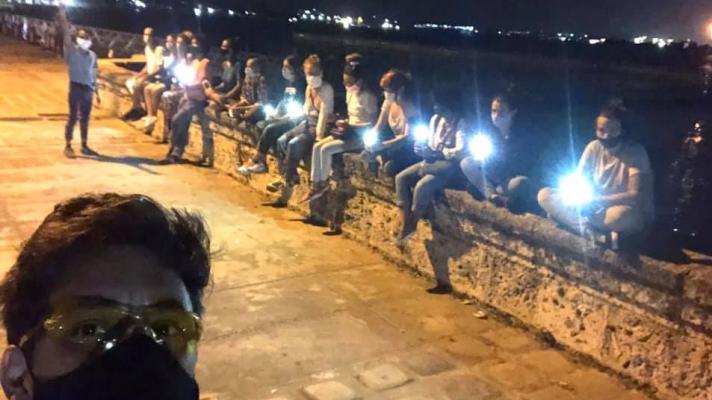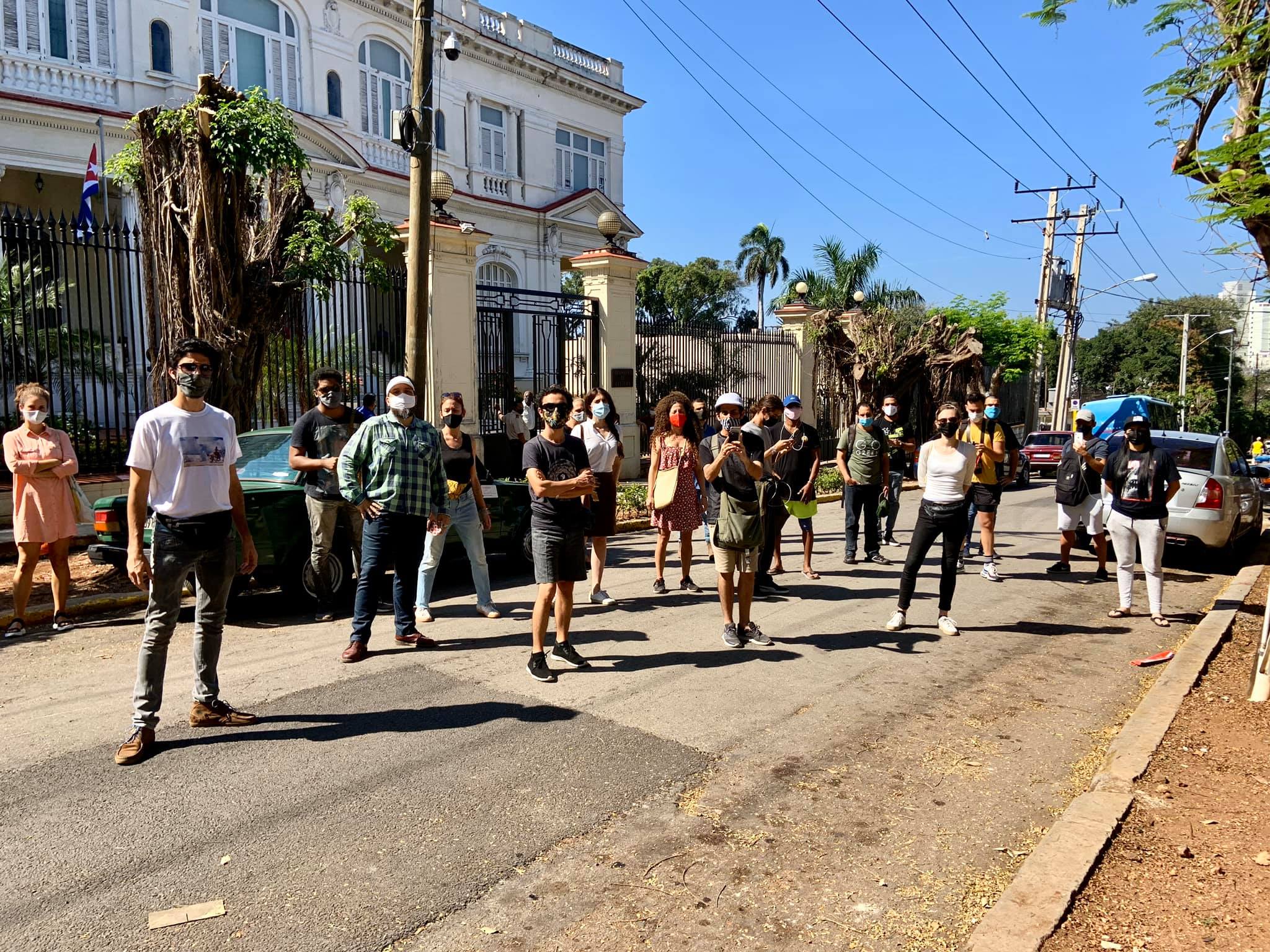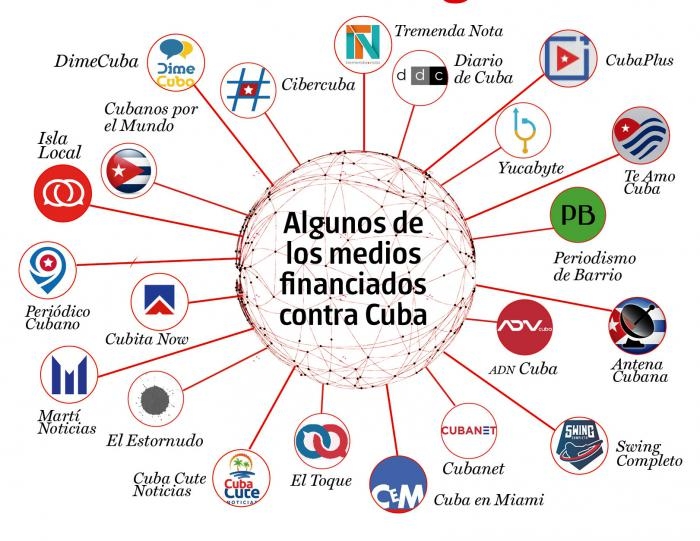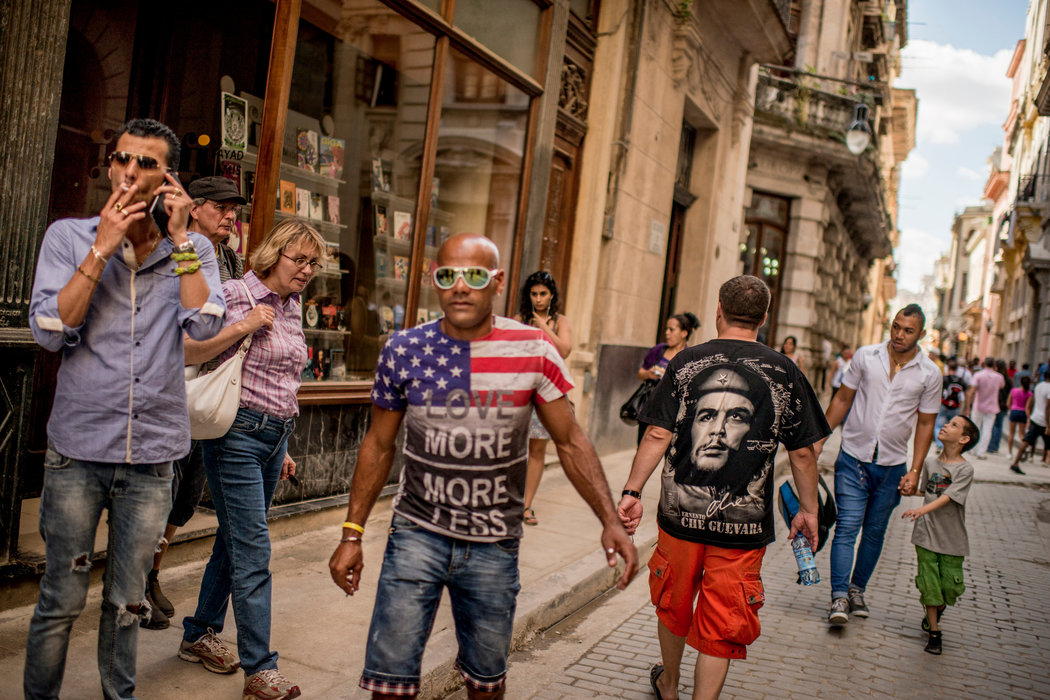Misión Verdad
 The San Isidro Movement is once again playing the leading role in color coup tactics in Cuba (Photo: Archive).
The San Isidro Movement is once again playing the leading role in color coup tactics in Cuba (Photo: Archive).
More than 70% of the Cuban population was born under the U.S. blockade of Cuba, the only one of its kind in the world because of its duration but also because of the capacity of the people to resist and overcome a continuous aggression. This has molded the ways of being and behaving within Cuban society.
The Global North has taken note of what has happened to the customs, daily life, lifestyles, behaviors, perceptions, creations and other elements of their culture, as well as their interaction with the new communicational elements centered on the Internet and social networks.
That is why the San Isidro Movement (MSI) appears in the Cuban political scene, since the government of that country published, in July 2018, the decree 349/2018 that regulates artistic activity, Cuban artists’ associations have reacted to it. The legal instrument was to go into effect on December 7 but was criticized by figures who support the revolutionary government, such as Silvio Rodríguez, and received strong opposition from other artists, including some who participate in the global art market.
Protests against the decree, some of which included violent and destabilizing actions, led to the arrest of people linked to the MSI who sought to escalate a major conflict rather than engage in dialogue, even though they were released. It has also generated debates and several meetings between authorities and cultural sectors, for which the government decided to suspend it and study further clarifications.
New round to fuel the permanent conflict
The MSI campaign has sought to involve those who critically support the new statute and generate controversy among activists and cultural professionals, supported by the U.S. Embassy in Havana which, at the time, tweeted in favor of “artistic freedom”, with a highly undiplomatic slogan: “No to Decree 349”. In addition, the operators of the diplomatic headquarters have opined regarding arrests and incidents in chorus with the cartelized press that their own government finances.
MSI members have been protesting the November 9, 2020 arrest of rapper Denis Solis, a member who received an eight-month jail sentence for assaulting a police officer. They have since drifted into calls for protests demanding Solis’ release and clamoring for freedom of speech (or to be publicized).
Last January 27, three months after the events that took place in the same place, three people linked to the events of last November had been summoned for a space for dialogue, however a group of approximately 30 people gathered in front of the Mincult (Cuban Ministry of Culture) with the supposed aim of protesting against several arrests that day and were summoned to dialogue on the spot by the Vice Minister of Culture, Fernando Rojas, to which the group refused.
Later, the same Minister of Culture, Alpidio Alonso, showed up at the rally and, after one of the demonstrators brought his cell phone close to his face, he snatched the device out of his hands. This served as an excuse to detonate the usual media spectacle to which a network of digital media joined, spreading the story of a “violent attack against young people who were demonstrating peacefully in front of the headquarters of the institution”.
 Three people were invited to dialogue at the headquarters of the Cuban Ministry of Culture but the MSI opted for a demonstration to fuel the conflict and its media positioning (Photo: OnCubaNews).
Three people were invited to dialogue at the headquarters of the Cuban Ministry of Culture but the MSI opted for a demonstration to fuel the conflict and its media positioning (Photo: OnCubaNews).
Cuban President Miguel Díaz-Canel denounced the actions promoted against State officials and entities, as a provocative action in an environment where the country is facing the hostile policy of the blockade.
It is dishonest to hide behind art to provoke by besieging institutions and public officials, while the nation fights tooth and nail against blockade, pandemic and death. Our ministries are not media platforms. Hard work is done there. #CubaEsCultura #CubaViva pic.twitter.com/1pmvorVtnp
– Miguel Díaz-Canel Bermúdez (@DiazCanelB) January 28, 2021
Synchronously in Miami, the MSI branch in that city demonstrated in favor of the detainees and the alleged assaulted. As is well known, the events of November caused a media stir because some members of the MSI staged a hunger strike to demand the release of Solis.
The novelty, which is not so much, is that the controversy is circumscribed around the Mincult; this gives an idea of the ongoing agenda. It is not only a question of bursting in on a legal decision but also of denying the dialogue offered on multiple occasions to fuel the ongoing conflict, the live transmissions to social networks such as Facebook Live show that the motivation has been essentially mediatic. This is also demonstrated by the tweet from the U.S. Embassy in Cuba:
We are concerned by reports that Cuban officials assaulted peaceful protesters seeking freedom of expression and that of detained colleagues. We urge the government to listen and dialogue with its people instead of resorting to arrests, violence, and cutting off the Internet. https://t.co/6k5drLfQ0L
– U.S. Embassy in Cuba (@USEmbCuba) January 27, 2021
On January 29, media outlets such as Cibercuba reported on the alleged detention of rappers Maykel Osorbo and Omar Mena of the MSI as they left their homes in Havana and Santa Clara, respectively. They also reported that activist and independent artist Luis Manuel Otero Alcántara had also been detained on his way to demonstrate at the Capitol.
There were also reports of the detention of rapper Maykel Castillo, a member of the MSI, as he was leaving his home, and of artist Yasser Castellanos in front of the Capitol steps. The same media reported that the detainees were released within hours, however the victimizing narrative persists as part of a psychological operation.
On February 2, a reporter from the U.S.-managed ADN Cuba website acknowledged in a video, which circulated on the networks, that he had received between 150 and 200 dollars to cover the event.
The human rights of the so-called “artivists” are insistently defended by Cubalex, an NGO funded by the National Endowment of Democracy (NED) and whose spokesperson in Cuba is Tania Bruguera, who has called, together with others from the MSI, to take over the Capitol in Havana as in the recent raid on Washington.
Who wants to be a mercenary? The business of funds
The viral articulation that seeks to show before the world a climate of ungovernability in Cuba and give signals to both the new Biden administration and its allies, also aims to impose a narrative about an incurable obscurantism in the Cuban Revolution, and, internally, to generate a climate of distrust and discredit towards institutionality.
In 2013, a report published by the U.S. Government Accountability Office (GAO) reported that the Obama administration promoted a social network equivalent to Twitter called “Zunzuneo” that sought to build a Cuban audience, mostly young people, which would then be induced to dissidence. This was also admitted by the then USAID administrator, Rajiv Shah.
In June 2017, former President Trump reinforced the attack on politicians, journalists and artists aligned with Cuban sovereignty by creating the “Internet Task Force” through a presidential memorandum. This entity hires netcenters (bots handlers), cyber-mercenaries and youtubers articulated with the media cartel created, organized and paid by Washington.
 A media network financed by U.S. agencies seeks to legitimize in Cuba the hegemonic vision of democracy and freedom through constant intoxication via social networks (Photo: Granma).
A media network financed by U.S. agencies seeks to legitimize in Cuba the hegemonic vision of democracy and freedom through constant intoxication via social networks (Photo: Granma).
Mother accounts generate messages of hate and negative perceptions that are replicated in the network of “independent” media and social networks, usually using people with certain recognition or popularity, who pretend to be journalists or opinion leaders, so that their words are taken as true, although they are not.
They are influencers with hypercritical tendencies, created to generate empathy and ideological tendencies in thousands of followers. Another element used is the one known as hater, the user who expresses hostility, reproduces hate speeches about people, specific groups of the population or about a topic.
In an article for Cuba Money Project entitled “The business of democracy in Cuba is booming”, journalist Tracey Eaton has pointed out the financing disguised in multiple ways to dozens of groups, through agencies, companies and organizations that are almost never transparent in the management of their funds. Sponsorship of actions that pursue subversion and coup d’état exceeded 249.5 million in the last two decades.
In 2020 alone, a report based on public information handled by agencies such as USAID on their digital portals estimates the sum to finance subversive initiatives at 2.5 million dollars. This is a partial figure, because “some programs are so secret that the recipients of the funds are never revealed,” explains Eaton.
The journalist also assures that at least 54 groups operated programs on the island with money coming from USAID or NED since 2017, coinciding with the arrival of Donald Trump to the presidency.
As interest in MSI grew, on Nov. 24 the U.S. State Department offered up to $1 million for programs that would increase “civil, political, religious, and labor rights in Cuba.”
Officials were seeking proposals that would “strengthen the capacity of independent civil society groups in Cuba to promote civil and political rights on the island and increase the accountability of Cuban officials for human rights violations and corruption.”
However, Eaton reveals only one layer of an extremely profitable business, as U.S. agencies and the government report having “undisclosed” contractors, to whom a part of the funds for a regime change in Cuba also go.
In order to receive funding in an expeditious manner, anti-Castro media such as El Toque, through the Más collective, based in Poland, or El Estornudo, created in Cuba and later legalized in Mexico, have registered in other countries as NGOs.
In the ZunZuneo case, front companies were created in Spain and the Cayman Islands since 2009 to hide the money trail, and hired CEOs without telling them they were going to work on a project funded by U.S. taxpayers. The $1.6 million spent was publicly listed as going to an unspecified project in Pakistan, but these documents do not reveal where the funds were actually spent.
In a covert USAID operation, the U.S. government built a social network ‘ZunZuneo’ to try to subvert Cuba’s government by luring a young audience to push them towards dissent. https://t.co/Ed5u3QbjZ6
– Camila (@PrensaCamila) February 9, 2021
Yazmín Vázquez Ortiz, from the Center for Hemispheric and U.S. Studies at the University of Havana, explained that financing, training and technical assistance are pillars, from which to take advantage of the conditions that exist in societies that may be subject to intervention, to promote resistance movements that can promote the change that the United States wants.
The deputy director of the same Center, Olga Rosa González Martín, pointed out that since it functions as a private organization, it receives private funds from any individual, from any corporation at the international level, which makes it more difficult to link an entity with a specific government and its foreign policy objectives in a given country.
The Institute for Peace and War Journalism, Factual, Distintas Latitudes, Swedish Foundation for Human Rights, Editorial Hipermedia, Diario de Cuba, Cubanet, Universidad Sergio Arboleda, and many others, function as contractors for these mercenary press projects. As a strategy, they select their future leaders, train them, reward them, finance them, stimulate them, make them visible, agglutinate them, empower them, orient them and give them spaces and platforms.
The penetration of the Internet has underpinned this facet of the cultural war, which is not new, while public sources of information from the U.S. government itself show the increase of funds during the last few years, at the same time that the Cuban State is undergoing transformations in its economic and social model.
Last January the MSI was nominated for the Freemuse Award for Freedom of Artistic Expression 2021 by the CADAL foundation (Center for the Opening and Development of Latin America), a right-wing entity based in Argentina and Uruguay that perceives itself as “a clear and constant voice in the promotion of democracy, the strengthening of institutions and the economic and social progress of Latin America”, and receives funds from the Ford Foundation and the Atlas Foundation.
 The “artivism” of members of the San Isidro Movement receives more and more funds and training to cause visual impact and disguise as art the change that the United States wants (Photo: Granma).
The “artivism” of members of the San Isidro Movement receives more and more funds and training to cause visual impact and disguise as art the change that the United States wants (Photo: Granma).
The nomination of the “artivists” is due to “their innovative work and great effort in confronting the coercive (!) measures of the Cuban government”.
In 2011, the NED published on its official website that it contributed 60 thousand dollars to Cadal and, up to 2012, nine of the 16 books she had published in partnership with different foundations and publishing houses, dealt with Cuban issues.
It has been denounced in that country for being an organization financed by the National Foundation for Democracy, which in turn has been financed by the CIA, and they started the “anti-communist” fight together with Fundación Libertad, the Center for the Implementation of Public Policies for Equity and Growth (CIPPEC), Fundación Vital Voice, Fundación Pensar, Fundación Creer y Crecer and several of the referents of regional politics, such as Mauricio Macri, Laura Alonso and Patricia Burllich.
Imaginaries and values as the spoils of the cultural and permanent war
The cultural war, as has been said, is not new, nor is the multidimensional, structural and systemic crisis of capitalism: that is why the attacks against any system of government that does not contribute to sustain its liberal imaginary based on the individualism of the few are intensifying.
The machinery for the dissemination of political and cultural values in the United States does not take into account respect for the sovereignty of nations and the cultural diversity of peoples; beyond mere influence, it practices covert and overt interference in the internal affairs of other states.
The debate is not limited to what a group of artists do or think, not even to the violence they generate or seek to generate. There are denser elements that seek to change the way of thinking of citizens, to create an uncritical mass of people who do not believe or work for any revolution, and nothing is more useful than culture as a spectrum of change of values.
Bruguera’s own statements on several occasions are eloquent: art “to try new political structures” (2005), “a means for other things” (2008). In the logic of these operators, there are no cultural restrictions in the United States as there are in Cuba, they transmit it by ignoring the Trump episode against the TikTok app of Chinese origin or the discrimination against Russian journalists in the United States, the United Kingdom, Germany and France.
The insistent and costly effort of the United States to present itself as the cultural model for the world, just as it wishes to be socially, economically and politically, is part of a business but also of a war. It is based on the notion that culture is merchandise and, therefore, what sells is what is promoted, i.e., if the elites can successfully market banality, sex and violence, then so be it. Profit is the guiding criterion. The U.S. culture war against the world goes beyond mere influence, it practices covert and overt interference in the internal affairs of other states to impose and standardize with its mercantilist values as “normality” (Photo: Archive).
The U.S. culture war against the world goes beyond mere influence, it practices covert and overt interference in the internal affairs of other states to impose and standardize with its mercantilist values as “normality” (Photo: Archive).
All this became clear when, in 2005, the United States and Israel equated freedom of creation with the free market in art. That year, in Paris, Unesco adopted the Convention on Cultural Diversity, which establishes that culture is not just another commodity, and grants States the sovereign right to promote and protect their cultural, tangible and intangible production against any measure they consider a threat.
The text was approved by 148 votes in favor and 2 against: the latter were from the United States and Israel, whose delegates argued that promoting true cultural diversity is about fighting for individual freedoms so that everyone can have “cultural liberty” and “enjoy their own cultural expressions and not those imposed by governments”.
Elier Ramirez Cañedo, from the Granma media, believes that the model of the Global North imposes the capitalist market as the primary standard for artists, which is why that government not only protects the market economy internally, but also opposes the sovereign right of other countries to protect their traditional culture.
The U.S. promotion of “democracy,” “freedom of expression” and “individual rights” is so all-encompassing that it includes the cultural issue, and is listed as one of the objectives of such funding.
It will never be said that these are colonizing onslaughts by the global hegemonic industry, with specific culture war projects designed, financed and implemented both to dominate societies affectively and cognitively and to impose and standardize certain groups and nations with their values.
A critical point is history: the more we can manipulate, distort the past and attack its most sensitive and symbolic bases, the better we will be able to sweep away the example of revolutionary processes such as those that occurred in Cuba, Venezuela, Nicaragua, Bolivia and Ecuador.
In her book The CIA and the Cultural Cold War, researcher Frances Stonor Saunders discusses how culture was a fundamental weapon during the Cold War against the socialist experiences of Eastern Europe. She describes that:
An important feature of the actions undertaken by the Agency to mobilize culture as a Cold War weapon was the systematic organization of a network of private “groups” and “friends,” within an informal consortium. It was a business-like coalition of philanthropic foundations, companies and other institutions and individuals working side by side with the CIA, as a cover and as a means of financing its secret programs in Western Europe.
It is a concept that, understood as a system, integrates or relates to elements of other terms that have been more widely used such as political warfare, psychological warfare, fourth generation warfare, smart power, soft coup, unconventional warfare and political-ideological subversion.
The White Paper of the U.S. Army Special Operations Command of March 2015 under the title “Special Operations Forces Support to Political Warfare” proposes that the United States should take up the idea of George F. Kennan, a U.S. strategist against the Soviet Union and architect of the policy of “containment against communism” in the State Department.
His approach is based on the need to overcome the limitation of the concept that establishes a basic difference between war and peace, in an international scenario where there is a “perpetual rhythm of struggle in and out of war”. In other words, war is permanent (hence the permanent conflict of the ISM and many other groups financed by the North), although it adopts multiple facets and cannot be limited to the use of military resources.
In fact, the document expresses that war can be waged without having declared it, and even wage war while declaring peace.
It adds:
The ultimate objective of Political Warfare is to win the “War of Ideas, which is not associated with hostilities.” Political Warfare requires the cooperation of the armed services, aggressive diplomacy, economic warfare and subversive agencies on the ground in promoting such policies, measures or actions necessary to disrupt or fabricate morale.”
The ideologist Zbigniew Brzezinski, former National Security Advisor to former President Jimmy Carter, in his work The Great World Board, said:
Cultural domination has been an undervalued facet of American global power. Whatever one thinks of its aesthetic values, American mass culture exerts a magnetic pull, especially on the world’s youth. That attraction may derive from the hedonistic quality of the lifestyle it projects, but its global appeal is undeniable. American television shows and movies account for about three-quarters of the global market. American popular music is equally dominant, while American novelties, eating habits and even clothing are increasingly imitated around the world. The language of the Internet is English, and an overwhelming proportion of global computer-mediated conversations also originate in the United States, influencing the content of the global conversation.
It is becoming increasingly clear that this was not a spontaneous movement and that its direction and direction towards a soft coup lead to constantly forcing scenarios of tension that trigger situations of conflict.
In addition to positioning this type of events, the aim is to wear down the official narrative in long explanations and answers that symbolically legitimize new faces inserted in operations that are “a means to other things”.
The Cuban cultural institutionality is the beachhead in this strategy whose bottom line is to progressively strip it of meaning. From there, the aim is to radiate a story of crisis to the rest of the State in order to force unruly rivers, escalations of chaos and spirals of violence.
Translation by Internationalist 360°